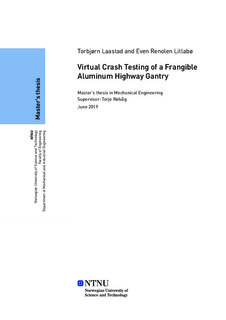| dc.contributor.advisor | Rølvåg, Terje | |
| dc.contributor.author | Litlabø, Even Renolen | |
| dc.contributor.author | Laastad, Torbjørn | |
| dc.date.accessioned | 2019-10-18T14:05:47Z | |
| dc.date.available | 2019-10-18T14:05:47Z | |
| dc.date.issued | 2019 | |
| dc.identifier.uri | http://hdl.handle.net/11250/2623227 | |
| dc.description.abstract | Tradisjonelt utføres fullskala kollisjonstesting for å vurdere sikkerhetsytelsen av ettergivende konstruksjoner
for veiutstyr. Denne oppgaven presenterer virtuell kollisjonstesting av en Lattix 4438
trafikkportal utført i samsvar med EN12767. Lattix er et norsk selskap som produserer og utvikler
ettergivende aluminiumsmaster for luftfart og veitrafikk. Det var ønskelig å avgjøre om portalen
kunne klassifiseres som ikke-energiabsorberende. Simuleringene ble utført i Abaqus eksplisit,
basert på en detaljert FE-modell, som inkluderer alle relevante strukturelle komponenter, kontakter,
grensebetingelser og boltforbindelser. Statens vegvesen supplerte kjøretøysmodellen som ble
brukt i simuleringene. Akselerasjons- og hastighetsdata ble hentet ut fra simuleringene for beregning
av Acceleration Severity Index (ASI) og Theoretical Head Impact Velocity (THIV). Disse
parametrene er indikatorer for potensiell personskade under en krasj.
ASI- og THIV-verdiene til portalen oppfyller kravene fra EN12767 for en ikke-energiabsorberende
struktur med betegnelse 100NE2. Samplingsraten ble vist å være kritisk for nøyaktigheten av ASIverdier,
og en samplingsrate på minimum 40 kHz anbefales. Simuleringer viser at bruddlasten til
baseboltene har større innvirkning på ASI enn forbindelsen mellom ben og tverrliggeren. Torsjon i
tverrliggeren kan være et problem og bør undersøkes videre. Dette ble ikke undersøkt i denne
oppgaven grunnet høye simuleringstider (41h for 0,275 s) simulert tid). Ikke-lineære statiske
analyser ble utført, noe som viste at portalen overlever en WL5 vindlastkategori for portal med en
sentermast og WL7 vindlastkategori for to sentermaster. | |
| dc.description.abstract | Traditionally, full-scale crash testing is performed to assess the passive safety performance of roadside
structures. This thesis presents virtual crash testing of a Lattix 4438 highway gantry in
accordance with EN12767. Lattix is a Norwegian company producing and developing frangible
aluminum masts for aviation and road traffic. The objective was to determine if the gantry could
be classified as non-energy absorbing. Simulations were performed in Abaqus Explicit, based on
a detailed FE assembly model including all relevant structural components, contacts, boundary
conditions, and bolt connections. The Norwegian Public Road Administration supplied the vehicle
model used in the simulations. Acceleration and velocity data were extracted from the simulations
for calculating Acceleration Severity Index (ASI) and Theoretical Head Impact Velocity (THIV).
These parameters are indicators of the potential occupant injury during a crash.
The ASI and THIV values for the gantry fulfill the EN12767 requirements for a non-energy
absorbing structure with designation 100NE2. The sampling rate was found critical for the
accuracy of ASI values, and a sampling rate of minimum 40 kHz is recommended. Simulations
show that the fracture load of the base bolts has a larger impact on ASI than the connection
between leg and transom. Torsion of the transom may be an issue and should be investigated
further. This was not investigated in this thesis due to the high simulation times (41h for 0.275
s simulated time). Non-linear static wind load analyses were performed, proving that the gantry
survives a WL5 wind load category for single center mast configurations and WL7 wind load
category for double center mast configuration. | |
| dc.language | eng | |
| dc.publisher | NTNU | |
| dc.title | Virtual Crash Testing of Frangible Aluminum Highway Gantry | |
| dc.type | Master thesis | |
